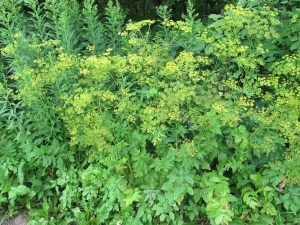Fall Lawn Care
This is a good time to do some improvements on your lawn. If you have crabgrass, lawn ivy (Creeping Charlie) or bare spots where the kids played badminton, now is the time to get to work. I recently called Paul Sachs, owner of North Country Organics and the author of three books on lawn care. He gave me some good suggestions.
Testing pH is a good first step, Sachs said. If your soil is too acidic or too alkaline, minerals can be bound up and unavailable to your turf plants even if they are present. You can get a simple test kit at a garden center, or take a sample and mail it to your state Extension Service soil testing lab for a more extensive report.
He warned that the first time someone adds limestone to their lawn – and fall is a good time for that – they may see a remarkable improvement the following spring. But, he warned, don’t keep on adding limestone without testing the pH. If you keep adding limestone every year your pH can get quite alkaline, which is just as bad as being too acidic.
According to Sachs, fall is a good time to overseed your lawn if you have thin or worn places, or if you have crabgrass. The soil is warm now, so new grass seeds will germinate more quickly than in the spring. Crabgrass, an annual, is declining in vigor so you can crowd it out by adding seed. Crabgrass seeds are not going to germinate until the spring, but if you can establish a nice thick turf now, crabgrass will have a hard time competing with it next spring.
It is best to sow a mixture of kinds of seed – a conservation mix that contains something like this: 35 percent creeping red fescue, 25 percent turf type tall fescue, 10 percent Kentucky bluegrass, 12 percent turf type perennial ryegrass, 15 percent annual ryegrass and 3 percent white clover. That mixture is good for a variety of soils and will thrive in full sun or even moderate shade.
Sachs told me that before you overseed an area, you should lower the height of the blades on your mower and give it a good haircut. That will allow newly started grass seeds to get more sunshine, which is important when it is getting established. So when filling in thin spots, you want to cut the grass close and allow new plants to develop.
Fall is also a good time to thicken the lawn by providing some fertilizer. An organic fertilizer like Pro-Gro will help roots to bulk up and winter-over better. Paul Sachs told me that when adding fertilizer it is good to keep the blades of mower up high, allowing each grass plant to have more surface area for photosynthesis. That will help to pump up its roots.
Knowing how much fertilizer to add and then figuring out how to spread it at the proper rate is a job for Einstein, I always thought. Paul Sachs helped me with the calculation. In general, he said you should add 20 to 30 pounds of fertilizer per 1,000 square feet of lawn if using Pro-Gro or other organic fertilizer with a 5-3-4 nutrient analysis (5-3-4 means 5 lbs of nitrogen, 4 of phosphate, 3 of potash per hundred weight).
A 20 by 50 foot section of lawn is 1,000 square feet. Figure out the total square footage of your lawn, calculate the amount of fertilizer you need for the job, and then buy the appropriate number of bags. Start applying it in a push-type spreader. If you set your spreader for a low rate of distribution, you can go over the lawn more than once until you have used all the fertilizer. Done. If part of the lawn got a little more than another part, no big deal – so long as every part of the lawn got some fertilizer.
Compaction makes it difficult to for grasses to thrive – except crabgrass, of course. That’s why crabgrass invades areas where you frequently walk. Years ago Sachs told me a simple way to test for compaction: you should be able to push a screwdriver with a 6-inch shaft into the lawn with moderate force. If you can’t, the lawn needs help.
You could hire a landscaper to come with a core-aerator or you could try to do something yourself. On-line I found an aerator at Sears for about $100 that can be pulled behind a riding lawn mower. It has 10 sharp steel stars that rotate and poke small 2-inch deep holes.
And then were the aerator sandals that strap onto your shoes with spikes that poke holes in the soil – only $16 but it would seem like a lot of work to aerate the lawn that way. Sachs said, “If you stomp your feet into really compacted soil, the only way to escape is to undo the straps and pry them out with your hands. I learned what it must feel like when a fly lands on fly paper.”
What about that pesky lawn ivy, commonly called Creeping Charlie? It is in the mint family and will grow almost anywhere. Sachs suggested raking it out with a short-tined garden and then fertilizing and overseeding. I tried raking it out, but found I pulled out my lawn grass, too. So maybe we just have to live with it. After all, if it’s green and you can mow it, I say it’s a lawn.
Henry is a gardening consultant and the author of 5 books. His website is www.Gardening-Guy.com. He lives and gardens in Cornish Flat, NH.



